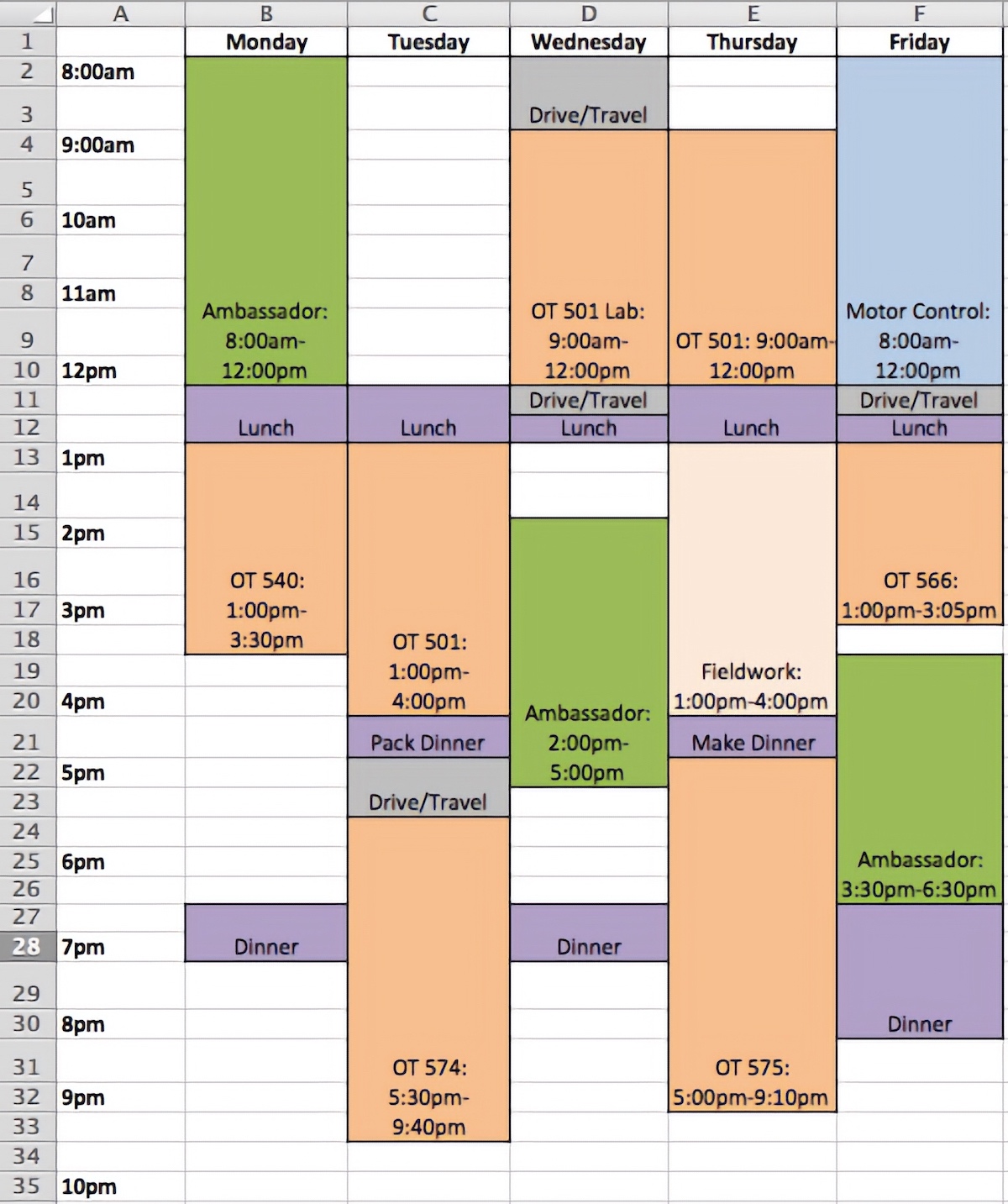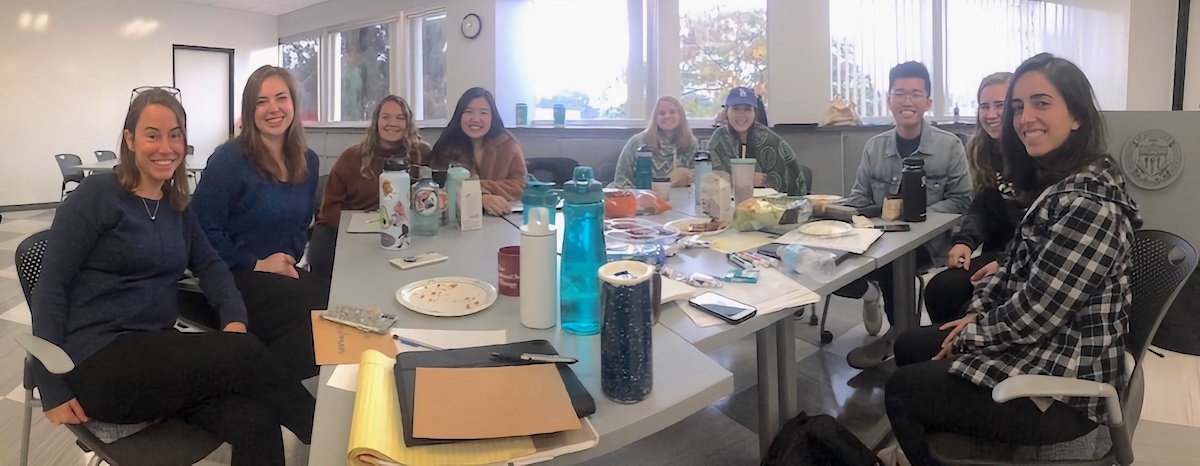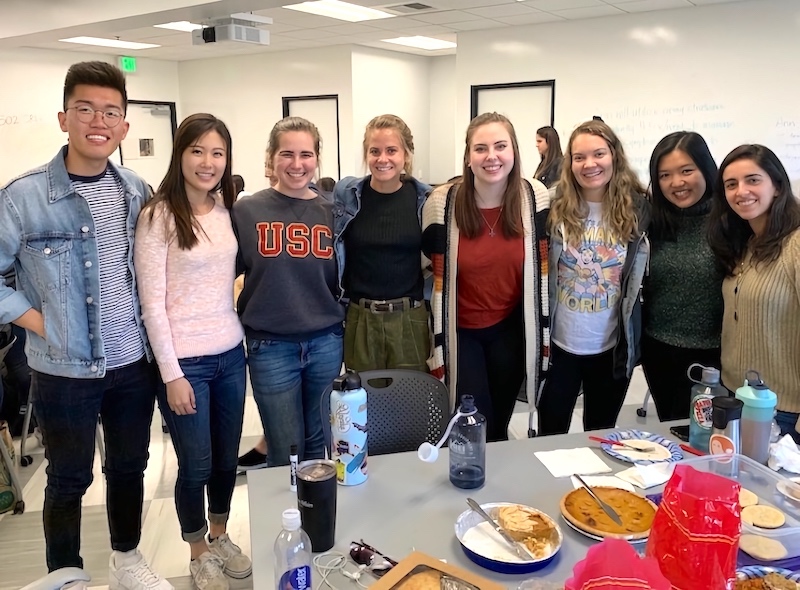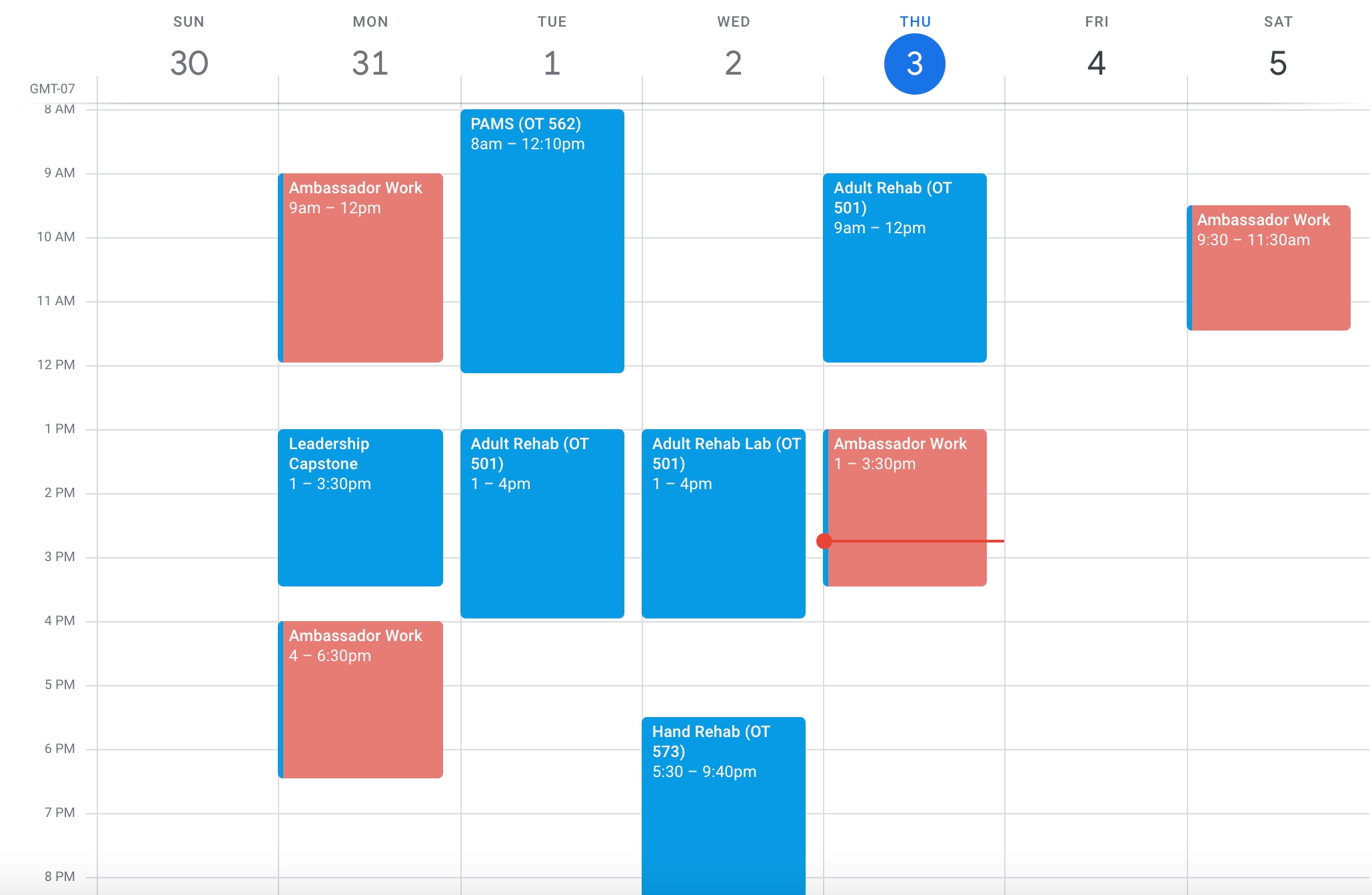Student Blog

So, You Have Submitted Your Application ⟩
September 11, 2020, by Lamoni
It is that time of the year when potential students are pressing that “submit” button! If that is you, congratulations! Completing applications is undoubtedly the most stressful part of applying to schools. You have completed all of your pre-requisites, spent several hours observing, gathered recommendation letters, wrote an impressive personal statement, sat 4 long hours to take the GRE, and maybe did a couple of interviews as well — CONGRATULATIONS! Please give yourself a pat on the back. Those are a lot of steps; You have already accomplished a lot.
But, nobody talks about the waiting game. This is also a very stressful time. I remember the big sigh of relief when I turned in all 9 of my OT school applications (Thank goodness for OTCAS am I right?). However, the feeling of relief was fleeting. Getting into OT school is a very competitive process and it only gets more competitive each year. The daunting question of “What if I don’t get in?” crossed my mind soon after submission.
I also had feelings of guilt because the number of things on my plate had significantly decreased. When applying, I was working, taking classes, observing, and studying. After, all I had to do was work. I was no longer extremely busy, and I felt weird about it. Was I doing enough? Should I be doing more?
I was also on OT blogs and OT reddit posts non-stop. Once people started posting their acceptances and rejections, the anxiety was unbearable. I started having dreams about checking my email!
It should not have been that stressful. That should have been my time to take a step back and breathe. If you are going through the same challenges that I went through, here is what you should do:
Create a Plan
Honestly, rejections happen. Sometimes it takes more than one try to do anything and that concept applies to getting into OT school. But it is not the end of the world. So, let’s not think of it that way. Instead, have a just-in-case plan ready. That way, if you are not accepted this time around, you will have action steps in your back pocket.During the wait, get the contact information for the directors of admissions at each of the schools you applied to. Most programs will allow you to reach out and ask about ways to strengthen your application. This way, you can have concrete suggestions on what to do instead of wondering where to start. For USC, here is the admissions team contact information.
Because we are all our biggest critic, you probably already have areas of your application that you would like to improve. For example, do you feel like you could have done better on the algebra section of the GRE? Do some practice algebra questions from time to time. Now that you have been through the process once, you have an idea of what you should focus on.
Stay (kind-of) Busy
Now that you have gotten into the routine of preparing your applications, it can be hard to break it. You don’t have to! Not all the way, at least. There’s no need to take more classes or revise your personal statement—that’s done. However, you can continue to observe and volunteer. It never hurts to increase your understanding of OT. See what the OTs in your area are doing in a variety of settings. Are most of your observation hours in pediatrics? Try mental health. Combine the two and try pediatric mental health. Did you mainly volunteer at camps? Try volunteering at a nursing home this time. This way, you are not only learning more about the profession, you are building your network. And continue to document these hours because . . . why not. Again, it doesn’t hurt.
Put Your Phone Down and Close Some of those Tabs
Why are you frantically checking your emails? It’s still September. They aren’t even sending out acceptance letters yet. Oh, and close all 6 of those forum tabs. The two YouTube videos named “how to get into OT school” is enough.
You spent more than enough time on your phone and computer during the application process. You have already seen and noted what’s on these forums and in these videos. Take a bit of a break.
Waiting is tough. Feeling like you are in lingo is challenging. But you have already done what needs to be done. Be patient with yourself and patient with the process. Add some time to your sigh of relief.
⋯

Tips to Stay Organized ⟩
September 10, 2020, by Savi
During my time in graduate school, I found that success is closely tied to organizational skills. Towards the beginning of each semester, I typically become overwhelmed by my new schedule and all of the combined assignments. I, therefore, have discovered a few simple ways to help ease my concern and make it ALL seem a little more manageable. Here is a list of a few tips you may find helpful to assist you with staying organized throughout the semester.
1. Weekly Schedule
Develop a weekly schedule PDF, Excel, or Word document that you can always refer to when you need to schedule a meeting, a study session with friends, a doctor’s appointment, or time to engage in a meaningful and rejuvenating occupation such as exercising. This weekly schedule can be color-coded and can include everything that you have committed your time to on a continuous weekly basis. This will allow you to view your weekly class, volunteer, fieldwork, and work schedule in one location, making it easy to see what time you have available in order to schedule events or utilize and assign your free time to activities and assignments. I also add in blocks for driving and eating to better understand what time I have completely free and what time I am filling with other necessary occupations. Here is my weekly calendar example:
2. Excel Assignment List
At the start of each semester I go through every single syllabus and note the assignment with the due date on an excel document. I color-code each class and then use the sort tool to organize the assignments by the due date. This way I can scroll through at the end of each week to see what I need to do over the weekend, plan what I can complete during my free time allotted in my weekly schedule, and check to make sure I have completed the all of the assignments before I go to bed each night. This is a quick and easy way to have all the assignments and exam due dates listed in one location! You can also delete the row or change the color of the assignment once it is completed to feel a sense of relief and instant satisfaction. Here is how I created mine:
Savi’s Assignments in an Excel List. To get from the first color-coded list to the second list organized by date due follow these instructions: 1. Highlight the “B” column as demonstrated in the picture on the left. 2. Select “Data” from the drop-down menu at the top of the screen. 3. Select “Sort” and choose the “expand the selection option”. 4. Select “Column B” option from the column drop-down and select the “January, February, March, April . . . December” option from the order dropdown. This option may be listed under “custom list” if you haven’t recently selected it. 5. Select the “ok” button at the bottom of the pop-up box and the excel sheet will sort your data!
3. Digital USC Folder
I created a folder for all things USC on my desktop. Inside this folder, I have created subfolders to save and organize my documents into. For example, I have folders for each semester. Once you open my semester folder you will find a folder listed for each class I am taking. This makes it extremely easy to find my notes, study guides, online textbooks, or anything else I need for each particular class.
4. Sticky Notes
I utilize the sticky note tool on my desktop to write down small to-do lists each day, reminders, and zoom links for class that aren’t linked through blackboard to make them easily accessible. If you do not have the sticky note tool on your desktop you can do this by hand in a planner, on your phone in a notes section, or in a word document that you can continuously update.
5. Shared Calendar
I have developed a monthly calendar that is linked to my computer and to my phone. That way if I add anything on one device it will automatically link to the other. This is helpful if I am out of the house and have to organize a meeting, event, or group project. You can do this on Outlook, Google Calendar, iCal, etc. I add my classes, any breaks or holidays to that calendar, and any appointments or future reminders in this calendar.
I hope this list has provided you with at least one technique that can help you stay organized this semester. Be sure to tailor these items to fit your particular needs!
⋯

My Mental Health Immersion Experience ⟩
September 7, 2020, by Calvin
I actually started off in the Mental Health Practice Immersion but, to be honest, I came into it with little to no interest in mental health. I just wanted to get it over with so that I could focus on the pediatric and adult rehabilitation immersions since my previous volunteer experiences were more related to those settings. However, throughout my time in the immersion, my perception of what occupational therapy’s role in mental health was had changed, and I realized that it’s just as important as other OT practice areas.
On the first day of class, I felt really nervous about going into this immersion because it was my first one ever. On top of that, I had no prior experience being in the mental health field, so my knowledge and insight were extremely limited. Nerves had really taken over during the first week, but my course instructors, Dr. Celso Delgado Jr. and Dr. Tessa Milman, were instrumental in reassuring and validating the entire cohort of our feelings. They said that the purpose of this course was to help introduce us to various perspectives so that we could understand the impact of mental health on occupational engagement, as well as the influence of occupation on recovery experiences. They also emphasized that it was okay to be feeling uncertain and sensitive to the experiences ahead, so I went in with an open heart and an open mind.
The mental health immersion incorporates a related Level I Fieldwork experience, in-service training, discussions with experts by experience, team debriefs and so many more opportunities. For my Level I Fieldwork, I was placed at a community mental health site and collaborated with mental health professionals, as well as peer specialists with lived experience. Now, this may sound surprising, but there was actually no occupational therapist at my site. According to the 2015 AOTA Salary & Workforce Survey, only 2.4% of respondents worked in the mental health practice setting. I was definitely shocked by this statistic, but it pushed me to really try and inform my site of the distinct value of OT. However, even with that ambition, I still yearned for guidance from an OT and, towards the beginning, I had a difficult time understanding what occupational therapy’s role was in mental health.
I had this internal conflict where I felt like I had to spread my OT knowledge and make all this positive change. However, I realized that Level I Fieldwork experiences are meant more to be spaces for students to learn, observe, and gain exposure to the area of practice. I also had this perception that OT’s role in mental health was restricted because it seemed similar to what social workers and case managers do. However, I discovered that this isn’t true and that occupational therapy actually plays such an extensive role in community mental health. Although there is collaboration with professionals from other disciplines, OTs have the scope and capacity to address occupational needs, promote functioning in the community, analyze performance skills, and provide unique assessments and interventions. Not having an occupational therapist to guide me through my first fieldwork experience was challenging, but I was grateful for the opportunity to connect curriculum material with my immersive experience. I was also thankful to have had a very involved interdisciplinary team by my side to advocate for the OT profession and they always tried their best to provide me with as many resources as possible!
Finally, I want to talk about my experience with my Cohort B lab team! Within these groups, we did a lot of team-based learning, discussed the course material, interacted with experts by experience, and debriefed about our fieldwork experiences. These people really made my experience in the mental health immersion and I honestly would not have gotten through this without them!
Team CarrOTs! | Pictured from left to right: Dr. Tessa Milman, Tess Mayer, Liz Broske, Bethany Hom, Morgan Smith, Helen Han, Sam Randolph, Adi Nisimov | Picture credits to our Expert by Experience 😊!
My favorite part about this course was the team debriefs, where we would each share about how our different Level I Fieldwork experiences were going. This opportunity opened up a safe space for us to learn about different mental health sites, share our challenges, provide advice and feedback, and just act as each other’s emotional support systems. An expert by experience also participated by sharing their thoughts and perspectives on how to approach certain situations at our respective sites. We were also incredibly grateful to have Dr. Tessa Milman as our team’s faculty supervisor and mentor. They each imparted such extraordinary mental health knowledge and expertise while also providing us with unwavering support throughout it all. These team-based discussions opened my eyes to the various potentials of mental health and how occupational therapy plays a special role in holistically addressing the needs and barriers of individuals experiencing mental health conditions.
This is us after we devoured the food from our Cohort B lunch potluck! Then we immediately went into a food coma haha!
In the beginning, I was nervous to start the mental health immersion because I had no prior experience or exposure. However, through this opportunity, I was able to challenge my implicit biases and build supportive relationships within my team and my fieldwork site. This empowered me to see the bigger picture and to develop a deeper understanding of the connection between occupational therapy and mental health. Regardless of what setting I go into, I know that I will be using my foundation of mental health knowledge in every endeavor I pursue!
Ending this post with appreciation collage for my team! Don’t worry, these pictures were taken during class breaks~
⋯
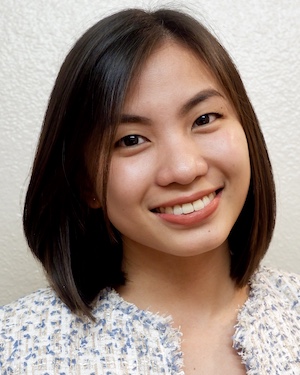
Love is sweeter the second time around ⟩
September 4, 2020, by Yna
The first time I fell in love with OT was more than 7 years ago (I can’t believe it’s already been that long!). Right from the beginning, I always knew I wanted to have a career in a healthcare-related profession, but I wasn’t sure which field in particular. I entered the Occupational Therapy program with plans to continue on to medical school right after I graduate. However, as I got to know more about OT, I inevitably fell in love with it and felt that I actually was meant to be there. I then explored diverse practice settings as an OT intern and later on a licensed practitioner—pediatric development, adult physical rehabilitation, community-based rehabilitation, geriatrics, and mental health. Each interaction I had with a client was a unique and humbling experience that has served to prove the many ways that OTs can make a difference in our clients’ lives. The famous saying “OTs add life to years, not just years to life” indeed holds true.
Fast forward to several years later, I found myself choosing OT yet again, this time as a graduate student of the Post-Professional Master’s program. I must admit that I initially had my inhibitions about going back to school, but thanks to the efforts of Dr. Danny Park and the whole Global Initiatives team, the transition couldn’t have been smoother. Early into the program, I already got a sense of how expansive USC Chan’s curriculum is when I was presented with a number of choices for my elective courses—some of which I didn’t even know existed! Right then and there, it felt as though I was being introduced to OT once again as I saw a whole new set of possibilities unravel for my future career path. It is for this reason that I can firmly say, I’ve made the right choice. USC Chan definitely gave me more reasons to fall in love with OT the second time around.
⋯

What Might My Schedule Look Like? ⟩
September 3, 2020, by Liz
There’s so much that comes to mind when asking yourself, “what’s grad school like?” What will my schedule look like? Will I have time to do things I enjoy outside of school or is it super intense? Will I be able to work while enrolled in the program? Will I be able to take care of additional responsibilities? I wanted to share a little bit more about that through this post. To start off, here’s my Google calendar!
This reflects what my schedule looks like as a second year student. The pink squares are the times I am at work and the blue squares show when I am in class. The Hand Rehabilitation and PAMS courses are both the electives I chose for the semester. So, the schedule may look a little different for other students depending on their elective choices.
As you can see, for the most part my days start at about 9 AM, with 8 AM being the earliest. I am not really a morning person, however as I shared in one of my previous blog posts I took Lifestyle Redesign over the summer. Well, one of my goals while taking that elective was to switch my workout routine from the evening to the early morning in order to have more time to do other things later on in the day. Yes, it was definitely a struggle to try and do this, but staying active is something that is important to me! Anyway, I usually wake up at about 6:30 AM on Mondays and Wednesdays to get a little exercise in before class. I also work out on Friday and Sunday mornings, but wake up a bit later on those days to get some sleeping in. On the days that I do not exercise in the mornings, I wake up about an hour before class starts to make breakfast, tidy up my room, and get ready for class. So, be ready to start the day early in order to make it in time!
It’s only been two weeks since the fall semester started, and I already have a lot of readings to do for adult rehab. Adult rehab is one of the three practice immersions offered in our program. I’ve successfully completed pediatrics and mental health, so now I am tackling the final immersion! We have a quiz every week, which is first taken individually and then with our group. It’s important to get these readings done in order to be prepared for the quizzes, but also to get the most out of the learning experience. In addition to those readings, I also have readings for my other classes to get through.
As you can see from my calendar, I have Fridays and Sundays entirely free. I am also free Saturdays after 11:30 AM. I do most of my work during the weekend, but I also do some work during the week so as not to overwhelm myself. I would say I engage in roughly about 10 hours a week of study time. This includes reading for classes, any sort of presentation I have to work on, writing papers, reviewing class material and working on asynchronous assignments. This may sound like a lot, but it is doable. I will say, grad school is not like undergrad where you can maybe get away with not doing the readings! I find that actually reading for class has made me feel so much more prepared to engage during lecture and also to ask questions. Although I spend a lot of time doing stuff for school outside of class, I make sure to give myself little breaks throughout the day!
As far as work goes, as a student ambassador I am currently working 10 hours a week. Luckily, the job is very flexible. For example if I needed extra study time on Monday to review for an exam for Tuesday morning’s PAMS class I can shift my work time over to Friday. As I mentioned earlier, there is a lot of time that goes into studying during the week in addition to attending class. So, I think working while enrolled in the program is doable if your job is flexible and won’t interfere with schoolwork. I wouldn’t recommend working any more than 10 hours a week so that you don’t overwhelm yourself. But again, no one knows you better than you do and only you know what you can handle! If money is a huge stressor, there are several scholarship opportunities available within the Division, USC, and through outside sources that can help lift a little bit of that financial stress. There are also student worker positions available that can also help.
When I am not in class my schedule does allow me to spend time with the people I love! My partner and I enjoy ordering Shake Shack for dinner and watching movies. I also have time to visit my parents and my younger sister for a few hours during the weekend. I am also able to spend some time outside, watch Netflix, and hang out with my roomies. And as an update, I did get a new roomie, Max, who I am completely obsessed with! Here he is ready to take on the UCLA football team!

So, to wrap things up, definitely expect to put in a few hours into studying outside of class. You really do get what you put into it! But, also keep in mind that there’s time for you to do the things you love. It’s all about time management and really planning out your week/month in advance. You can do this!
⋯








